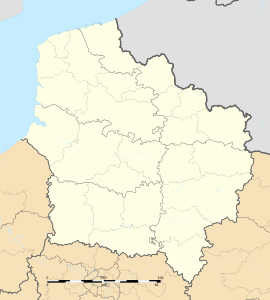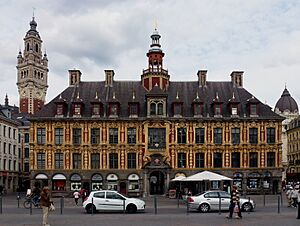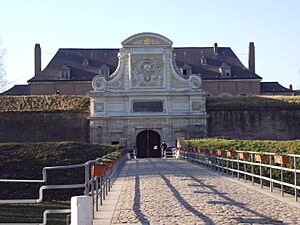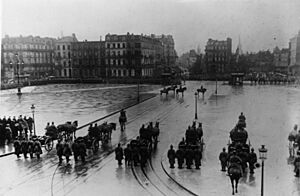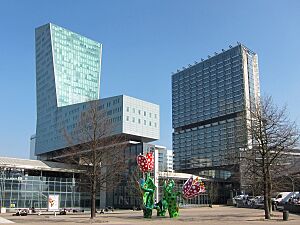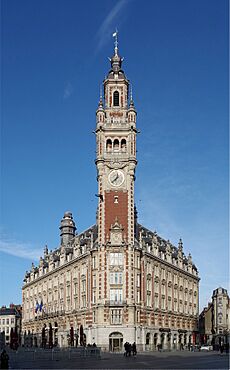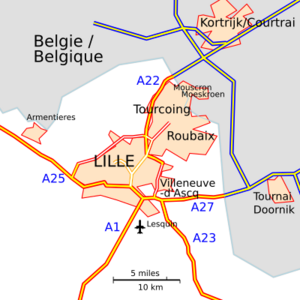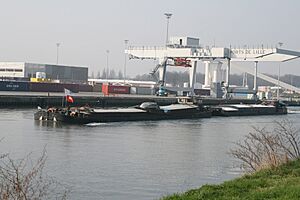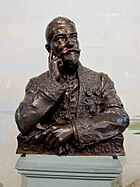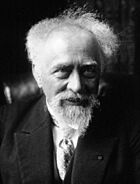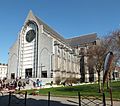Lille facts for kids
Quick facts for kids
Lille
|
|||
|---|---|---|---|
|
Prefecture and commune
|
|||
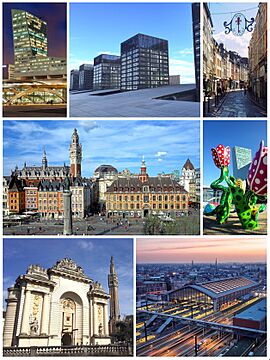
From top to bottom, left to right: the Lille Tower, some towers of Euralille, the Rue de la Clef in Old Lille, the Place du Général-de-Gaulle, the Shangri-La tulip sculpture for Lille 2004, the Porte de Paris with the belfry of the City Hall and Lille-Flandres train station
|
|||
|
|||
| Country | France | ||
| Region | Hauts-de-France | ||
| Department | Nord | ||
| Arrondissement | Lille | ||
| Canton | Lille-1, 2, 3, 4, 5 and 6 | ||
| Intercommunality | European Metropolis of Lille | ||
| Area
1
|
34.8 km2 (13.4 sq mi) | ||
| • Urban
(2020)
|
446.7 km2 (172.5 sq mi) | ||
| • Metro
(2020)
|
1,666.4 km2 (643.4 sq mi) | ||
| Population
(2021)
|
236,710 | ||
| • Rank | 10th in France | ||
| • Density | 6,802/km2 (17,617/sq mi) | ||
| • Urban
(Jan. 2020)
|
1,053,636 | ||
| • Urban density | 2,358.71/km2 (6,109.0/sq mi) | ||
| • Metro
(Jan. 2020)
|
1,515,061 | ||
| • Metro density | 909.182/km2 (2,354.77/sq mi) | ||
| Time zone | UTC+01:00 (CET) | ||
| • Summer (DST) | UTC+02:00 (CEST) | ||
| INSEE/Postal code |
59350 /59000, 59800
|
||
| 1 French Land Register data, which excludes lakes, ponds, glaciers > 1 km2 (0.386 sq mi or 247 acres) and river estuaries. | |||
Lille is a vibrant city located in northern France, close to the border with Belgium. It sits along the Deûle river and is the main city of the Hauts-de-France region. Lille is also the capital of the Nord department and the center of a large urban area called the Métropole Européenne de Lille.
In 2020, about 236,234 people lived in Lille itself. However, when you include its French suburbs, the greater Lille area is home to over 1.5 million people. This makes it the fourth largest metropolitan area in France, after Paris, Lyon, and Marseille. Lille is also part of a huge connected area with Belgian cities like Mouscron and Kortrijk. This larger area, called the Eurometropolis Lille–Kortrijk–Tournai, has more than 2.1 million residents.
Lille is often called the "Capital of Flanders" in France. It has a long and exciting history, from the Middle Ages to modern times. The city was often under attack and belonged to different countries, including France, the Burgundian State, and Spanish Netherlands. It finally became part of France for good under King Louis XIV. Lille also faced tough times during the two world wars in the 20th century, suffering from occupation and destruction.
For a long time, Lille was a major center for trade and manufacturing, especially in textiles and machinery. After these industries declined in the 1960s, the city went through a difficult period. But in the 1990s, Lille started to change, focusing more on service industries. Today, the old part of the city, called Old Lille, is famous for its beautiful 17th-century red brick houses and charming streets. The belfry (bell tower) of the Lille City Hall is even a UNESCO World Heritage Site, recognized for its unique architecture.
The building of the Euralille business district in 1988 and the arrival of high-speed trains like the TGV and Eurostar in 1994 connected Lille to major European capitals like Paris, London, and Brussels. The city also hosts big events like the annual Braderie de Lille, which attracts millions of visitors. With over 110,000 students, Lille is a significant university city in France. In 2004, it was named a European Capital of Culture, showing its importance in arts and culture.
Contents
Discovering Lille's Past
How Lille Began
Archaeological findings suggest people lived in the Lille area as early as 2000 BC. The first known inhabitants were Gauls, followed by Germanic peoples like the Saxons.
An old legend says the city of Lille was founded in 640. The Dutch name for Lille, Rijsel, means "at the island," which is similar to the Old French name "l'Isle" (the Island). This name likely came from the city's original location on an island in the marshes.
From 830 to about 910, Vikings invaded the Flanders region. After these invasions, the eastern part of the area was ruled by local princes.
The first official mention of Lille was in 1066, when it was called apud Insulam (Latin for "at the island"). At that time, it was part of the County of Flanders, a very rich and successful region in Europe.
Lille in the Middle Ages
In the 12th century, Lille became famous for its cloth fair, where textiles were traded. A big battle took place in Lille in 1054.
In 1214, the French won a major battle at Bouvines. This led to Infante Ferdinand, Count of Flanders being imprisoned. His wife, Jeanne, Countess of Flanders, then ruled Lille. People in Lille, who numbered about 10,000, loved her.
Jeanne gave Lille a special city charter in 1235. This allowed citizens to choose their own city leaders. In 1236, she founded the Countess's Hospital, which still exists today.
After Jeanne died in 1244, Lille came under French rule from 1304 to 1369. Later, it became part of the Burgundian State and was one of its three main capitals, along with Brussels and Dijon. By 1445, Lille had about 25,000 residents.
In 1477, Lille became part of the lands ruled by Maximilian of Austria.
Lille in Early Modern Times
The 16th and 17th centuries saw a big increase in the textile industry. However, there were also Protestant uprisings and outbreaks of the plague.
Lille was ruled by Holy Roman Emperor Charles V in 1519, and then by Philip II of Spain in 1555. It remained under Spanish rule until 1668. During this time, there were attempts by Protestant rebels to take the city, but they failed.
In 1667, Louis XIV of France, also known as the Sun King, successfully took Lille. It officially became French in 1668. To win over his new subjects, Louis XIV started important public works, like building the Citadel (a strong fortress designed by Vauban).
From 1708 to 1713, the Dutch occupied Lille during a war. Throughout the 18th century, Lille remained a very Catholic city. It played a small part in the French Revolution, but there were some riots and churches were damaged. In 1790, the city held its first local elections.
Lille After the French Revolution
In 1792, after the French Revolution, the Austrians attacked Lille. The city bravely resisted, led by Mayor François André-Bonte. Even though Austrian cannons destroyed many homes and the main church, Lille did not give up. The Austrians left after eight days. A monument called the "Column of the Goddess" was built in 1842 to honor the city's resistance.
Lille continued to grow, reaching about 53,000 residents by 1800. In 1846, a railway line connected Paris and Lille. In the early 1800s, Napoleon I's blockade against the United Kingdom helped Lille's textile industry grow even more. The city became known for its cotton production.
In 1858, Lille expanded by adding nearby towns like Esquermes and Wazemmes. By 1872, Lille's population was 158,000, and it grew to over 200,000 by 1891. In 1896, Gustave Delory became the first socialist mayor in France, leading Lille.
By 1912, Lille had 217,000 people. The city became very wealthy thanks to the Industrial Revolution, especially from coal mining and the textile industry.
Lille During the First World War
German forces occupied Lille on October 13, 1914, after a ten-day attack. This attack destroyed many buildings, especially near the train station and in the city center. Lille was close to the battlefields, so German troops often passed through. The city became a place for treating wounded soldiers and for soldiers to rest. Many buildings were taken over for these purposes.
Lille was freed by the Allies on October 17, 1918. General Sir William Birdwood and his troops were welcomed by happy crowds.
Lille Between the World Wars
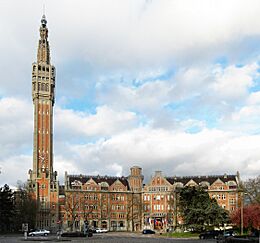
In July 1921, at the Pasteur Institute in Lille, scientists Albert Calmette and Camille Guérin discovered the first vaccine against tuberculosis, known as BCG. The Opéra de Lille, a beautiful opera house, opened in 1923.
From 1931, Lille was affected by the Great Depression. By 1935, one-third of the city's population was living in poverty.
Lille During the Second World War
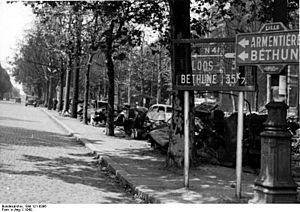
During the Battle of France in 1940, German forces attacked Lille for several days. Many citizens, remembering the First World War, fled the city. Lille was controlled by the German military, not by the French Vichy government.
British, Canadian, and Polish troops liberated most of the Nord and Pas-de-Calais regions from September 1 to 5, 1944. On September 3, German troops started leaving Lille as the British approached. The city was freed by a British tank force.
Rationing ended in 1947, and by 1948, life in Lille returned to normal.
Lille After the Wars
In 1969, the "Lille urban community" was created, connecting Lille with 87 other towns.
Throughout the 1960s and 1970s, the region faced challenges as the coal, mining, and textile industries declined. From the early 1980s, Lille began to focus more on the service sector.
Pierre Mauroy was the Mayor of Lille for 28 years, from 1973 to 2001. He also served as Prime Minister of France for a time.
In 1983, the VAL metro system opened in Lille. It was the world's first automated underground network. In 1993, a high-speed TGV train line connected Paris and Lille in just one hour. The opening of the Channel Tunnel in 1994 and the arrival of the Eurostar train placed Lille at the center of a travel triangle between Paris, London, and Brussels.
Work on Euralille, a big urban development project, began in 1991. The Euralille Centre opened in 1994, and the area now has parks, modern offices, shops, and apartments.
Lille in the 21st Century
Lille was chosen as a European Capital of Culture in 2004, sharing the title with the Italian city of Genoa.
In 2007 and 2010, Lille was recognized as an "Internet City."
Lille's Weather and Environment
Lille's Climate
Lille has a mild oceanic climate. Summers are usually not too hot, and winters can get cold, sometimes below freezing, but the average temperatures stay above freezing. It rains quite a bit throughout the year.
| Climate data for Lille (LIL), elevation: 47 m (154 ft), 1991–2020 normals, extremes 1944–present | |||||||||||||
|---|---|---|---|---|---|---|---|---|---|---|---|---|---|
| Month | Jan | Feb | Mar | Apr | May | Jun | Jul | Aug | Sep | Oct | Nov | Dec | Year |
| Record high °C (°F) | 15.2 (59.4) |
19.0 (66.2) |
24.8 (76.6) |
27.9 (82.2) |
31.7 (89.1) |
34.8 (94.6) |
41.5 (106.7) |
37.1 (98.8) |
35.1 (95.2) |
27.8 (82.0) |
20.3 (68.5) |
15.9 (60.6) |
41.5 (106.7) |
| Mean daily maximum °C (°F) | 6.6 (43.9) |
7.5 (45.5) |
11.2 (52.2) |
15.0 (59.0) |
18.4 (65.1) |
21.3 (70.3) |
23.7 (74.7) |
23.7 (74.7) |
20.2 (68.4) |
15.4 (59.7) |
10.3 (50.5) |
7.0 (44.6) |
15.0 (59.0) |
| Daily mean °C (°F) | 4.1 (39.4) |
4.7 (40.5) |
7.5 (45.5) |
10.5 (50.9) |
13.8 (56.8) |
16.7 (62.1) |
18.9 (66.0) |
18.8 (65.8) |
15.8 (60.4) |
11.9 (53.4) |
7.6 (45.7) |
4.7 (40.5) |
11.3 (52.3) |
| Mean daily minimum °C (°F) | 1.7 (35.1) |
1.9 (35.4) |
3.8 (38.8) |
5.9 (42.6) |
9.3 (48.7) |
12.1 (53.8) |
14.2 (57.6) |
14.0 (57.2) |
11.4 (52.5) |
8.4 (47.1) |
4.9 (40.8) |
2.3 (36.1) |
7.5 (45.5) |
| Record low °C (°F) | −19.5 (−3.1) |
−17.8 (0.0) |
−10.5 (13.1) |
−4.7 (23.5) |
−2.3 (27.9) |
0.0 (32.0) |
3.4 (38.1) |
3.9 (39.0) |
1.2 (34.2) |
−4.4 (24.1) |
−7.8 (18.0) |
−17.3 (0.9) |
−19.5 (−3.1) |
| Average precipitation mm (inches) | 58.2 (2.29) |
50.8 (2.00) |
52.1 (2.05) |
45.3 (1.78) |
61.6 (2.43) |
63.7 (2.51) |
67.8 (2.67) |
71.3 (2.81) |
56.8 (2.24) |
64.1 (2.52) |
75.0 (2.95) |
73.3 (2.89) |
740.0 (29.13) |
| Average precipitation days (≥ 1.0 mm) | 11.2 | 10.6 | 10.1 | 9.2 | 9.5 | 9.8 | 9.9 | 9.9 | 9.7 | 10.8 | 13.3 | 12.2 | 126.2 |
| Average snowy days | 4.9 | 4.1 | 3.2 | 1.3 | 0.1 | 0.0 | 0.0 | 0.0 | 0.0 | 0.0 | 1.8 | 3.8 | 19.2 |
| Average relative humidity (%) | 88 | 85 | 82 | 79 | 78 | 79 | 78 | 78 | 83 | 87 | 89 | 90 | 83 |
| Mean monthly sunshine hours | 62.2 | 73.6 | 127.3 | 175.9 | 195.7 | 201.5 | 209.7 | 196.8 | 155.3 | 115.3 | 61.7 | 52.5 | 1,627.4 |
| Source 1: Meteo France | |||||||||||||
| Source 2: Infoclimat.fr (relative humidity and snow days 1961–1990) | |||||||||||||
Air Quality in Lille
Lille is known for its air pollution. A 2018 study found that air pollution contributed to about 1,700 deaths each year in the Lille area. In 2018, Lille also had some of the highest pollution levels in France.
Lille's Population Over Time
The population numbers for the city of Lille itself (about 35 square kilometers) include areas that were added to the city over time, like Hellemmes-Lille in 1977 and Lomme in 2000.
The larger Lille metropolitan area, which covers 1,666 square kilometers in France, had a population of 1,515,061 in 2020.
|
|
||||||||||||||||||||||||||||||||||||||||||||||||||||||||||||||||||||||||||||||||||||||||||||||||||||||||||||||||||||||||||||||||||||||||||||||||||||||||||||||||||||||||||||||||||||||||||||||||||||||||||||||||||||||||||||||||||||
Lille's Economy and Jobs
Lille used to be a big center for manufacturing, especially in textiles and machinery. Now, it's the main city in a network of cities including Roubaix, Tourcoing, and Villeneuve-d'Ascq. This area, the Métropole Européenne de Lille, is France's fourth-largest urban area.
How Jobs Have Changed in Lille
Over the last 50 years, Lille's job market has shifted from mostly industry to service jobs. In 2006, services made up 91% of all jobs.
| Business area | 1968 | 1975 | 1982 | 1990 | 1999 | 2015 |
|---|---|---|---|---|---|---|
| Agriculture | 340 | 240 | 144 | 116 | 175 | 74 |
| Industry and construction | 51,900 | 43,500 | 34,588 | 22,406 | 15,351 | 8,427 |
| Tertiary activities | 91,992 | 103,790 | 107,916 | 114,992 | 122,736 | 149,795 |
| Total | 144,232 | 147,530 | 142,648 | 137,514 | 138,262 | 158,296 |
| Sources of data: INSEE | ||||||
| Farmers | Businesspersons, entrepreneurs |
Upper class | Middle class | Employees | Blue-collar worker | |||||||
|---|---|---|---|---|---|---|---|---|---|---|---|---|
| 1968 | 2017 | 1968 | 2017 | 1968 | 2017 | 1968 | 2017 | 1968 | 2017 | 1968 | 2017 | |
| Lille | 0.1% | 0.0% | 7.8% | 3.6% | 7.5% | 29.0% | 16.7% | 26.0% | 33.1% | 25.0% | 34.9% | 13.4% |
| France | 12.5% | 1.3% | 9.9% | 6.0% | 5.2% | 16.3% | 12.4% | 24.8% | 22.5% | 28.5% | 37.6% | 21.5% |
| Sources of data : INSEE | ||||||||||||
| 1968 | 1975 | 1982 | 1990 | 1999 | 2007 | 2017 | |
|---|---|---|---|---|---|---|---|
| Lille | 2.9% | 4.6% | 10.3% | 14.6% | 16.9% | 16.7% | 19.2% |
| France | 2.1% | 3.8% | 7.4% | 10.1% | 11.7% | 11.5% | 13.9% |
| Sources of data : INSEE | |||||||
Businesses in Lille
By the end of 2015, Lille was home to about 28,000 businesses in industry and services.
| Enterprises | Number of employees | Total employees | |||||
|---|---|---|---|---|---|---|---|
| None | 1 to 9 | 10 to 19 | 20 to 49 | 50+ | |||
| Agriculture | 20 | 17 | 2 | 0 | 0 | 1 | 74 |
| Industries | 804 | 543 | 186 | 27 | 23 | 25 | 5423 |
| Construction | 1606 | 1247 | 282 | 45 | 24 | 8 | 3004 |
| Commerce, transports, services | 16410 | 11742 | 3721 | 477 | 294 | 176 | 55707 |
| Car sales and repair | 4815 | 3105 | 1495 | 138 | 48 | 29 | 12962 |
| Administration, education, health, social work | 4536 | 3357 | 599 | 196 | 181 | 203 | 81126 |
| Total | 28191 | 20011 | 6285 | 883 | 570 | 442 | 158296 |
| Source of data : INSEE | |||||||
Places to See in Lille
Lille's buildings show a mix of styles, often with Flemish influences, using brown and red bricks. Many homes, especially in the greater Lille area, are attached two or three-story houses with small gardens in the back. These building styles are quite unique in France and link Lille to nearby Belgium, the Netherlands, and England.
Some interesting places to visit include:
- Birthplace of Charles de Gaulle
- Lille Cathedral (Basilique-cathédrale Notre-Dame-de-la-Treille)
- Citadel of Lille
- Palais des Beaux-Arts de Lille (Fine Arts Museum)
- Jardin botanique de la Faculté de Pharmacie (Botanic Garden)
- Jardin botanique Nicolas Boulay (Botanic Garden)
- Jardin des Plantes de Lille (Garden of Plants)
- Maison Folie Moulins
- Lille Synagogue
The Braderie de Lille
Lille hosts a huge annual street market called the braderie on the first weekend of September. It's thought to have started in the 12th century. Between two and three million visitors come to the city for it. It's one of the biggest gatherings in France and the largest flea market in Europe.
Many streets in the city center are closed, and local shops, residents, and traders set up stalls to sell their goods.
Getting Around Lille
Public Transportation
The Métropole Européenne de Lille has a very modern public transport system. It includes buses, trams, and a driverless light metro system, all run by Transpole. The Lille Metro opened in 1983 and was the world's first automatic light metro line. It has two lines, covering 45 km with 60 stations. The tram system has two lines connecting central Lille to Roubaix and Tourcoing, with 45 stops. There are also 68 bus routes covering the area, with 8 of them reaching into Belgium.
Train Travel
Lille is a key hub for high-speed trains in Europe. You can reach London in 80 minutes on the Eurostar. The French TGV network connects Lille to Paris in just one hour, and to Brussels in 38 minutes. It also links to other major French cities like Marseille and Lyon. Lille has two train stations right next to each other: Lille-Europe station for high-speed and international trains, and Lille-Flandres station for regional and Belgian trains.
Road Network
Five major highways pass through Lille, making it one of the busiest road networks in France outside of Paris:
- Autoroute A27: Connects Lille to Tournai, Brussels, Liège, and Germany.
- Autoroute A23: Connects Lille to Valenciennes.
- Autoroute A1: Connects Lille to Arras, Paris, Reims, Lyon, Orléans, and Le Havre.
- Autoroute A25: Connects Lille to Dunkirk, Calais, England, and North Belgium.
- Autoroute A22: Connects Lille to Antwerp and the Netherlands.
Air Travel
Lille Lesquin International Airport is about 15 minutes from the city center by car. It's the fourth-largest French river port for shipping, handling almost 38,000 tonnes of goods each year. Its passenger traffic is smaller, around 1.2 million in 2010, because it's close to bigger airports in Brussels and Paris-CDG. The airport mainly connects to other French and European cities.
Waterways
Lille is the third-largest river port in France, after Paris and Strasbourg. The Deûle river connects Lille to a network of over 680 km of waterways. This allows boats to travel to Northern Europe via the Scarpe and Scheldt rivers (to Belgium and the Netherlands), and internationally via the Lys river (to Dunkerque and Calais).
Learning and Education in Lille
With over 110,000 students, Lille is one of France's major student cities.
The State University of Lille was founded in 1854, with famous scientist Louis Pasteur as its first dean of the Faculty of Sciences. It later split into three separate universities in 1970. In early 2018, these three universities merged again to form the new University of Lille, which now has 70,000 students.
Other important higher education institutions in Lille include:
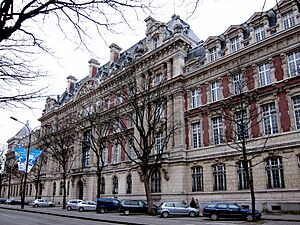
- The Arts et Métiers ParisTech, an engineering school for industrial and mechanical engineering, opened in Lille in 1900.
- École Centrale de Lille, one of France's top engineering schools, founded in Lille in 1854.
- École nationale supérieure de chimie de Lille, a chemistry school founded in 1894.
- École supérieure de journalisme de Lille, a journalism school created in 1924.
- Skema Business School, a top business school founded in 1892.
- IEP Sciences-Po Lille, a political studies institute founded in 1992.
The Université Catholique de Lille is a large private university founded in 1875. It includes faculties for law, economics, medicine, and physics, as well as various schools like:
- École des hautes études commerciales du nord (EDHEC), a business school founded in 1906.
- École des Hautes études d'ingénieur (HEI), an engineering school founded in 1885.
- Institut catholique d'arts et métiers (ICAM), an engineering school founded in 1898.
- IESEG School of Management, a management school founded in 1964.
Famous People from Lille
Artists and Writers
- Renée Adorée (1898–1933), actress
- Émile Bernard (1868–1941), painter
- Carolus-Duran (1837–1917), painter
- Alain Decaux (1925–2016), TV presenter and writer
- Pierre De Geyter (1848–1932), composed the music for The Internationale
- Julien Duvivier (1896–1967), film director
- Yvonne Furneaux (1928–), actress
- Iris Mittenaere (born 1993), model, Miss France 2016, and Miss Universe 2016
- Philippe Noiret (1930–2006), actor
- Albert Samain (1858–1900), poet
Scientists and Mathematicians
- Charles Barrois (1851–1939), geologist
- Joseph Valentin Boussinesq (1842–1929), mathematician and physicist
- Albert Calmette (1863–1933) and Camille Guérin (1872–1961), discovered the anti-tuberculosis vaccine
- Jean Dieudonné (1906–1992), mathematician
- Charles Frédéric Kuhlmann, (1803–1881), chemistry professor
- Louis Pasteur (1822–1895), microbiologist
- Jean Baptiste Perrin (1870–1942), Nobel Prize winner in physics
Sports Figures
- Nabil Bentaleb (born 1994), footballer
- Amandine Henry (born 1989), footballer
- Lucas Pouille, tennis player
- Didier Six (born 1954), footballer
- Raphaël Varane (born 1993), footballer
Media and Sports in Lille
Local newspapers in Lille include Nord éclair and La Voix du Nord.
The national public television network, France 3, has a channel focused on the local area: France 3 Nord-Pas-de-Calais.
Lille's main football club, Lille OSC, plays in Ligue 1, the top French football league. The club has won several national trophies and often plays in European competitions like the UEFA Champions League. In the 2010–11 season, Lille won both the league and the cup.
Lille's Stade Pierre-Mauroy stadium hosted the final stages of the FIBA EuroBasket 2015 basketball tournament. This venue will also host handball events for the 2024 Summer Olympics.
Lille is also home to Lille Lacrosse [fr], a successful lacrosse team that has been a national champion in France.
Lille's International Connections
Lille has sister city relationships with many cities around the world:
 Buffalo, United States
Buffalo, United States Cologne, Germany
Cologne, Germany Erfurt, Germany
Erfurt, Germany Esch-sur-Alzette, Luxembourg
Esch-sur-Alzette, Luxembourg Haifa, Israel
Haifa, Israel Kharkiv, Ukraine
Kharkiv, Ukraine Leeds, England, United Kingdom
Leeds, England, United Kingdom Liège, Belgium
Liège, Belgium Nablus, Palestine
Nablus, Palestine Oujda, Morocco
Oujda, Morocco Rotterdam, Netherlands
Rotterdam, Netherlands Saint-Louis, Senegal
Saint-Louis, Senegal Tlemcen, Algeria
Tlemcen, Algeria Turin, Italy
Turin, Italy Valladolid, Spain
Valladolid, Spain Wrocław, Poland
Wrocław, Poland
Images for kids
-
Anglican Christ Church
See also
 In Spanish: Lille para niños
In Spanish: Lille para niños





